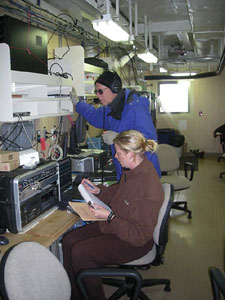

 | |||||||||||
|
|
Journals 2008/2009Heather Judkins
August 6, 2008 One of the ongoing projects onboard is the acoustics monitoring program. Tina Yack is the acoustician for this leg of the cruise. I found some time to pick her brain about the monitoring she does each day. The acoustics team is responsible for deploying a hydrophone array into the water at sunrise, record any sounds that come up, and bring in the hydrophones at sunset. This isn't as easy as it sounds. There is a set of five hydrophones that are in the water with three of them picking up high frequency sounds coming from porpoises and beaked whales. Two of them picking up mid frequencies that come from other toothed whales. The scientists are listening for whistles and echolocation using two automated systems to assist in picking up the various whale sounds.
Why are they spending months and months listening to the whales? I found the answer. They are trying to determine the distribution and abundance of the various marine mammal groups via acoustic monitoring. They work independently of the marine mammal observers and when the studies are complete, the two projects cross check each other to see if any whales were missed by either group. Studies in the past have shown that acoustics will pick up more beaked whales than the observers and the observers will pick up more of the baleen whales and rough toothed dolphins. Why is it difficult for acoustics to detect the baleen whales? This is because the sound frequency that the whales use is much lower of a frequency that the hydrophones can pick up. So, the scientists also deploy sonobuoys when the whales are in close proximity to the ship. These are small transmitters that can be deployed to detect low frequency sounds in the water within a one- mile range of the ship.
One of the main goals for the acousticians is to record the beaked whale sounds and attempt to determine their population density. This is a priority because there have been many strandings of these whales and some think this may be due to the mid frequency sonar used by the Navy in the worlds oceans. One of the challenges for the scientists is maintaining the enormous amount of software and hardware it takes to effectively monitor the whales. Tina is using five computers for this leg, which she is constantly monitoring. The rewards are huge in that there has been success in tracking and finding the animals they are looking for! They are learning tons about the whales behavior and ecology from these studies. Question 1: How fast does sound travel in the water? Question 2: Look online and explain how echolocation works in marine mammals. Be complete! |
||||||||||

